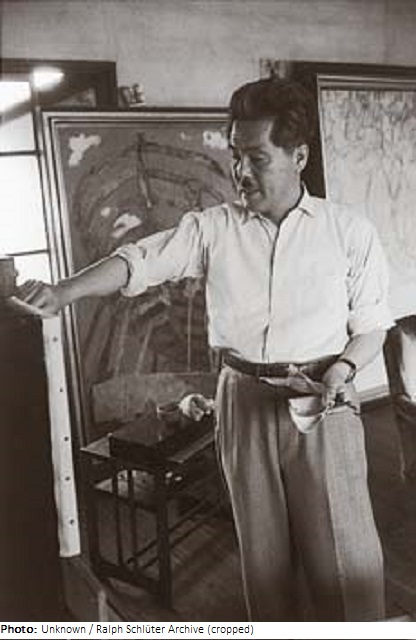Kinosuke Ebihara

Biographical information
| Roles | Competed in Olympic Games |
|---|---|
| Sex | Male |
| Full name | Kinosuke•Ebihara |
| Used name | Kinosuke•Ebihara |
| Original name | 海老原•喜之助 |
| Born | 13 September 1904 in Kagoshima, Kagoshima (JPN) |
| Died | 19 September 1970 (aged 66 years 6 days) in Paris XVIe, Paris (FRA) |
| NOC |  Japan Japan |
Biography
After attending Kagoshima prefectural junior high school, Kinosuke Ebihara studied at Tokyo under Ikuma Arishima and entered the Kawabata Art School in 1921. While still enrolled at Kawabata he studied French in the Athéné Français in order to go to France, which he did in 1923. There, he visited Tsuguharu-Léonard Fujita and was invited to the Salon de l’Escalier. Ebihara held an individual exhibition in New York in 1928. During his stay in France, Ebihara created a series of snowy landscapes resembling the world of a fairy tale. Also typical for his work were the use of the blue colors and frequent horse motifs.
Ebihara returned to Japan in 1934 and presented his works at the Nika-kai (Second Section Association), and other independent exhibitions, but also at the Salon d’Automne in Paris. During World War II, he spent more than one year in Dalian in occupied China. After the war, he settled on Kyushu Island, where he founded his own art institute in the city of Kumamoto in April 1951. It closed in 1953 but was re-opened from 1957 until 1966.
Ebihara’s works from the 1950s continued to build his world-wide reputation and won him a number of prestigious awards. In 1960, he returned to the Tokyo region and took up residence in Zushi in the Kanagawa Prefecture. At the 1964 Tokyo Olympic Games his “Rainy Day” was featured during the “Modern Japanese Art” exhibition. In January 1968 he went to Europe and stayed with his friend Fujita during the last weeks of his life. He traveled in Europe, visiting various places, but eventually died in Paris from cancer of the digestive system.
His painting Skating today bears the Japanese title Sukēto, but initially Pachinājiyu (after the Italian term “Pattinaggio” for skating). It was painted during his time in Paris in the typical Ebihara blue that has become famous. It bears the number 60 and measures 130 x 97 cm. It is also possible, however, that the painting submitted in 1936 was another very similar one from the same series.
Results
| Games | Discipline (Sport) / Event | NOC / Team | Pos | Medal | As | |
|---|---|---|---|---|---|---|
| 1936 Summer Olympics | Art Competitions |  JPN JPN |
Kinosuke Ebihara | |||
| Painting, Paintings, Open (Olympic) |